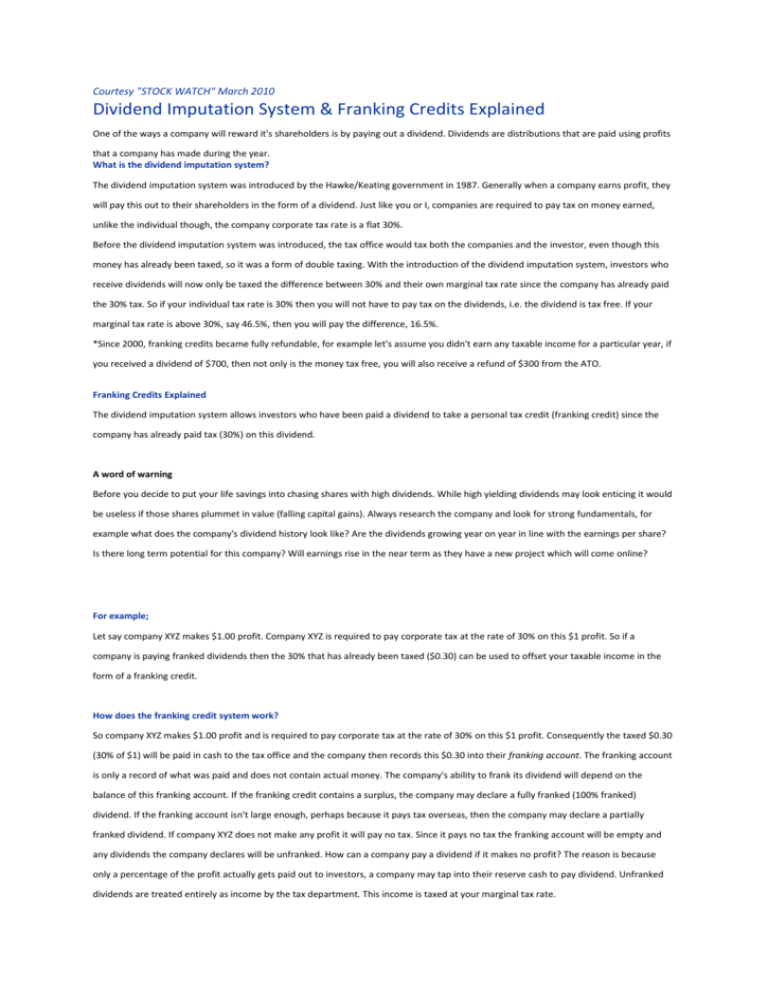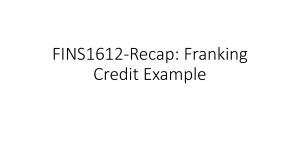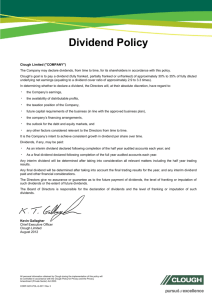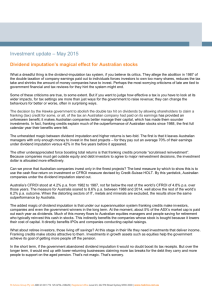What is the dividend imputation system?
advertisement

Courtesy "STOCK WATCH" March 2010 Dividend Imputation System & Franking Credits Explained One of the ways a company will reward it's shareholders is by paying out a dividend. Dividends are distributions that are paid using profits that a company has made during the year. What is the dividend imputation system? The dividend imputation system was introduced by the Hawke/Keating government in 1987. Generally when a company earns profit, they will pay this out to their shareholders in the form of a dividend. Just like you or I, companies are required to pay tax on money earned, unlike the individual though, the company corporate tax rate is a flat 30%. Before the dividend imputation system was introduced, the tax office would tax both the companies and the investor, even though this money has already been taxed, so it was a form of double taxing. With the introduction of the dividend imputation system, investors who receive dividends will now only be taxed the difference between 30% and their own marginal tax rate since the company has already paid the 30% tax. So if your individual tax rate is 30% then you will not have to pay tax on the dividends, i.e. the dividend is tax free. If your marginal tax rate is above 30%, say 46.5%, then you will pay the difference, 16.5%. *Since 2000, franking credits became fully refundable, for example let's assume you didn't earn any taxable income for a particular year, if you received a dividend of $700, then not only is the money tax free, you will also receive a refund of $300 from the ATO. Franking Credits Explained The dividend imputation system allows investors who have been paid a dividend to take a personal tax credit (franking credit) since the company has already paid tax (30%) on this dividend. A word of warning Before you decide to put your life savings into chasing shares with high dividends. While high yielding dividends may look enticing it would be useless if those shares plummet in value (falling capital gains). Always research the company and look for strong fundamentals, for example what does the company's dividend history look like? Are the dividends growing year on year in line with the earnings per share? Is there long term potential for this company? Will earnings rise in the near term as they have a new project which will come online? For example; Let say company XYZ makes $1.00 profit. Company XYZ is required to pay corporate tax at the rate of 30% on this $1 profit. So if a company is paying franked dividends then the 30% that has already been taxed ($0.30) can be used to offset your taxable income in the form of a franking credit. How does the franking credit system work? So company XYZ makes $1.00 profit and is required to pay corporate tax at the rate of 30% on this $1 profit. Consequently the taxed $0.30 (30% of $1) will be paid in cash to the tax office and the company then records this $0.30 into their franking account. The franking account is only a record of what was paid and does not contain actual money. The company's ability to frank its dividend will depend on the balance of this franking account. If the franking credit contains a surplus, the company may declare a fully franked (100% franked) dividend. If the franking account isn't large enough, perhaps because it pays tax overseas, then the company may declare a partially franked dividend. If company XYZ does not make any profit it will pay no tax. Since it pays no tax the franking account will be empty and any dividends the company declares will be unfranked. How can a company pay a dividend if it makes no profit? The reason is because only a percentage of the profit actually gets paid out to investors, a company may tap into their reserve cash to pay dividend. Unfranked dividends are treated entirely as income by the tax department. This income is taxed at your marginal tax rate. Around 52% of the companies in the ASX offers fully franked dividends *source choice magazine Fully Franked Dividends: Tax, Yields & Franking credits calculations Here is an example of what the tax implications are of franking credits. We will also compare franked dividend yields versus term deposit/fixed interest yield. Let's take a real life example; Suppose you had 625 units of shares in ANZ. ANZ share price is $16 and they announce a fully franked (100%) dividend of $1.20 per share Total invested: 625 X $16 = $10,000 Fully franked dividend income: 1.20 X 625 = $750 Franking credit formula: total cash dividend X 30/70* * assuming corporate tax rate of 30% Lets assume that your marginal tax rate is 45 percent plus a medicare levy (1.5%), total tax rate is 46.5%. With the franking calculation above we can see the benefits of the dividend imputation system. The fully franked credits has lowered the investors overall tax rate from 46.5% to 23.57% (100(573.22/750)). Comparing this to a term deposit or fixed interest Lets compare the yield of a fully franked dividend to a term deposit or fixed interest account earning the equivalent 7.5%. This is essentially the above example without the franking credits Term deposit/Fixed term interest Investment: $10,000 Total income: $750 Tax payable at 46.5%: After tax income: $348.75 Income Yield: 3.49% (348.75/10,000) So if we compare a fully frank dividend and fixed interest investment, both at 7.5%, we find that the fully franked share dividend is the much superior investment, yielding 5.73% versus 3.49%. For a fixed interest investment to earn the equivalent after tax income, it would need to yield 12.33% Partially Franked Dividends Let's look at the same example above but this time the ANZ dividends will be partially franked at 80% The partially franked imputation credit has effectively reduced the investor's tax rate from 46.5% to 28.16% Franking credits at different tax rates The benefits of the dividend imputation system. For the examples below we will use a dividend of $700. The 45 day rule As the examples have shown fully franked dividends and franking credits make investing in Australian shares a tax effective strategy. However, the ATO realises this and to prevent investors from abusing the system they introduced the 45 day rule. The 45 day rule states that shareholder must hold shares for 45 days (not counting days of purchase or sale) for any franking credits over $5,000.








